Cartoonist PROfiles (apologies to Jud*)
Skip to commentsProfiles of and interviews with Walt Handelsman, Brian Box Brown, Crockett Johnson, R. Alan Brooks, Jeff Smith, and Phil Hands. And Jud Hurd.
When Walt Handelsman Went Marching in to New Orleans
The Advocate and The New Orleans Times-Picayune celebrate the 35th anniversary of the arrival of editorial cartoonist Walt Handelsman as he left Scranton PA for The Big Easy.
A native of Baltimore, Handelsman holds degrees in art therapy and advertising. He worked for an ad agency before becoming an editorial cartoonist for a chain of suburban weekly newspapers near his hometown.
In 1985, he moved to The Scranton Times in Pennsylvania, where his work was syndicated to more than 75 publications, including The New York Times, Washington Post, Newsweek and the National Review.
Blake Pontchartrain at NOLA.com gives us Walt’s resume.
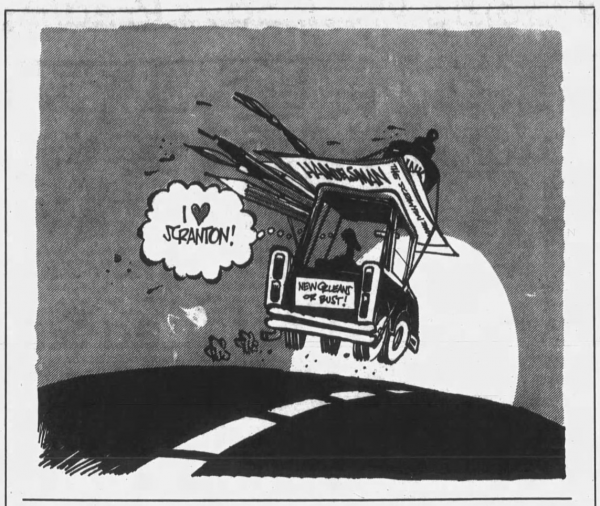
In August 1989, he joined The Times-Picayune, replacing fellow Pulitzer-winner Mike Luckovich, who left for the Atlanta Journal-Constitution. In New Orleans, Handelsman won all of the major national awards for editorial cartooning, including his first Pulitzer Prize in 1997.
In 2001, he left for Newsday in New York. There, he taught himself Flash animation and in 2007 became the first person to win a Pulitzer Prize for animated cartoons.
Handelsman returned to Louisiana in 2013 as cartoonist at The Advocate, which in 2019 purchased The Times-Picayune. Both newspapers, like Gambit, are owned by Georges Media Group.
**********
Shining the Heat Lamp on Brian Box Brown
Brian Box Brown, a renowned cartoonist from New Jersey, has carved a unique path in the world of comics by intertwining his passion for art with cannabis advocacy. His journey from a teenager discovering cannabis to an influential figure in the fight for legalization is both compelling and inspiring.
Brown’s foray into comics began around 2005 when he discovered that comics could depict real-life stories, not just superheroes or newspaper strips. This revelation transformed his understanding of the medium and led him to create numerous non-fiction comics.
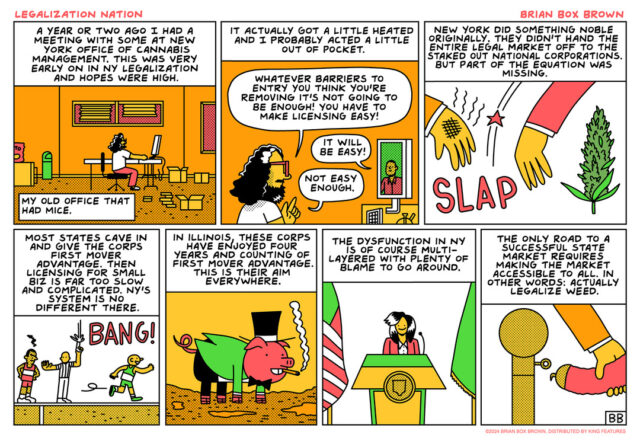
Red Rodriguez for stupidDOPE profiles cannabis legalization advocate Brian Box Brown.
Frustrated by the corporate domination and over-regulation in the cannabis market, Brown turned to his artistic talents to express his discontent. He created “Legalization Nation,” a comic strip that sheds light on the absurdities and injustices within the cannabis industry. Through his comics, Brown found a way to communicate complex issues in an accessible and impactful manner, resonating with many who shared his frustrations.
Legalization Nation is also carried by Comics Kingdom.
**********
When David Johnson Leisk became “Crockett Johnson”
“Harold and the Purple Crayon” has been a staple in children’s picture book collections ever since it was published in 1955. The author, Crockett Johnson, started his career as a cartoonist in periodicals and newspapers.
Born David Johnson Leisk, he established his pen name “Crockett Johnson” early on in his career. His early work can be found in New Masses, a weekly Marxist periodical from New York. Published from 1926 through 1948, New Masses aimed at revolutionizing the culture as well as politics. It featured essays and commentary on current national events as well as poems, artwork, cartoons, and book and theatre reviews.
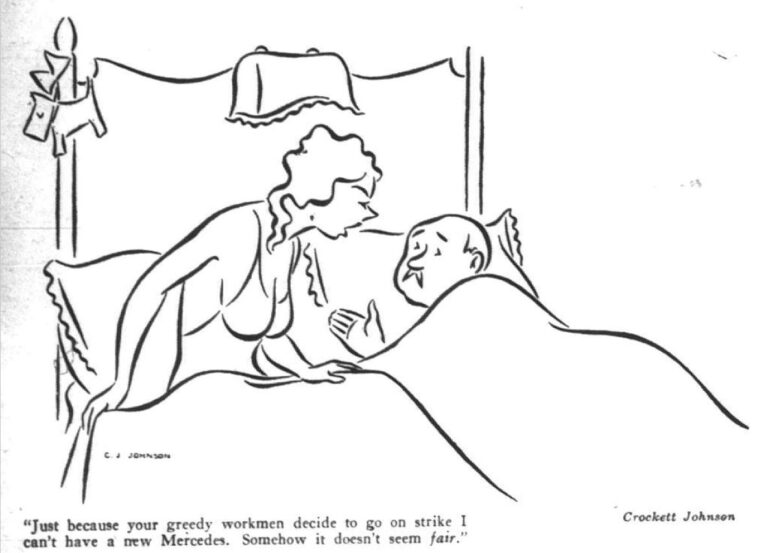
Johnson contributed editorial cartoons and illustrations from April 1934 till May 1940. He also joined the editorial board in 1936 and contributed the occasional review as well. At the time, other contributors to the periodical included Ernest Hemingway, Theodore Dreiser, Upton Sinclair, and Archibald MacLeish, who would become the Librarian of Congress in 1939.
Overlapping with his time at New Masses, Johnson also drew a weekly comic strip for Collier’s from March 1940 through January 1943. Collier’s was a weekly popular magazine established in 1888 that carried illustrated essays, nonfiction stories, and many one-panel cartoons.
Joanna Colclough for The Library of Congress runs through Crockett Johnson‘s cartooning career from magazines (New Masses, Collier’s) to syndicated comic strips (Barnaby) and comic panels (Barkis & Family).
With links to further reading.

More Crockett, King of The Purple Crayon
Is Crockett Johnson’s Harold, of “Harold and the Purple Crayon,” a child of color?
In 1998, HarperCollins relaunched the “Harold” books – seven picture books in which the title character, standing on a blank page, uses his purple crayon to draw the world and his adventures in it.
The physical copies of the new editions are larger, and the publisher modified the covers, changing the color of Harold’s jumper from white to blue and altering Harold’s original tan complexion to light peach – even though Harold remains tan within the pages of the books.
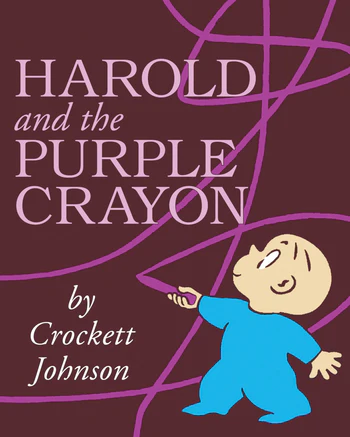

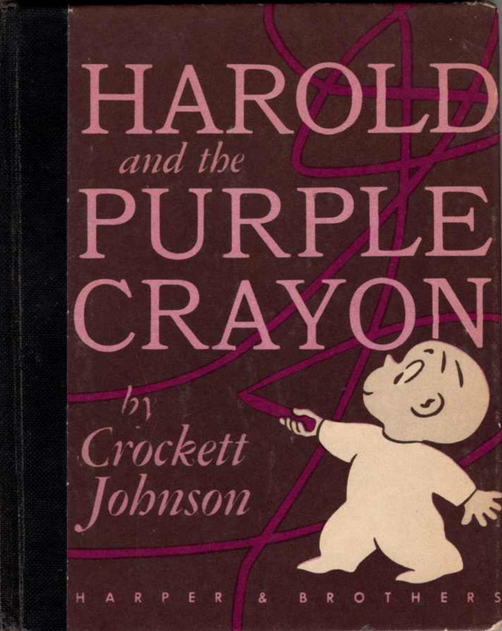
Fifty years ago, when I was a little white boy, I, too, read Harold as white. When I saw the new covers in 1998, I didn’t think they had changed Harold’s race. Now, however, I’m not so sure.
David Johnson Leisk biographer Philip Nel at SFGate discusses the color of Harold. He ain’t purple.
**********
R. Alan Brooks Doesn’t Miss Much

If you read the Colorado Sun, you might be familiar with the comic strip called ‘What’d I Miss?’ It follows conversations between Ossie – a young Black man – and Myra – an older white woman – who has awakened from a long coma.
Together they struggle to understand modern day politics and culture. Ossie and Myra talk about issues like artificial intelligence, disinformation on social media and more recently, the attempted assassination of Former President Donald Trump.
‘What’d I Miss?’ is written by Denver resident R. Alan Brooks.
KUNC radio host Erin O’Toole spoke with Brooks to talk about his work and life in comics.

The Colorado Sun archive of What’d I Miss? by R. Alan Brooks and Cori Redford goes back six years.
**********
Throwing Thorn a Bone
For a time, Jeff Smith’s comics masterpiece Bone was only available in a hefty collected edition numbering a staggering 1,360 pages, and when I started college 17 years ago, every friend, colleague, and professor in my major—not to mention related art majors adjacent to comics—had their own personal copy. For many, Bone was a glorious discovery they tried to convince their less comics-inclined high school friends to pick up before finding themselves in the midst of likeminded art nerds in college and learning that the series was nothing short of a movement: first within the comics world, then even across mainstream readerships.
But before Bone, there was Thorn—the “precocious college comic strip” that Smith penned for the Ohio State University paper the Lantern, per PW’s starred review of a new complete collection from Cartoon Books comprising those strips: Thorn: The Complete Proto-Bone College Strips 1982–1986, and Other Early Drawings. We spoke with Smith about how Thorn led to Bone and how his comics classic found a home at Scholastic, got him to share some excerpts from the new book, and more.
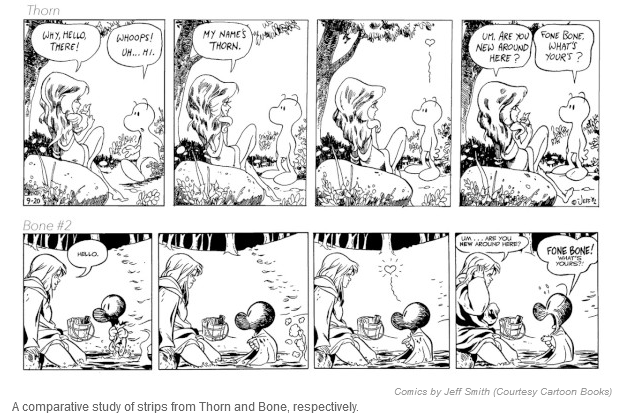
Matt Burbridge at Publishers Weekly interviews cartoonist Jeff Smith about his classic Bone and college Thorn.
**********
Hands on Political Cartooning
Phil Hands is the editorial cartoonist for the Wisconsin State Journal, making him part journalist, part artist and part comic. And in a year of unprecedented political moves and historic firsts, he’s never starving for ideas.

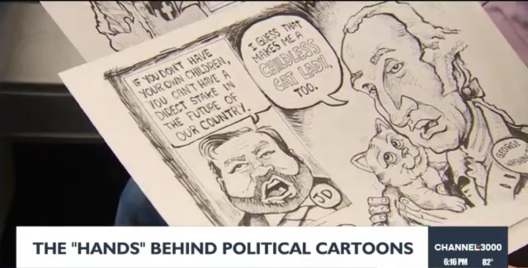
WISC-TV reporter Maddie Heimsch interviews Wisconsin State Journal editorial cartoonist Phil Hands.
**********
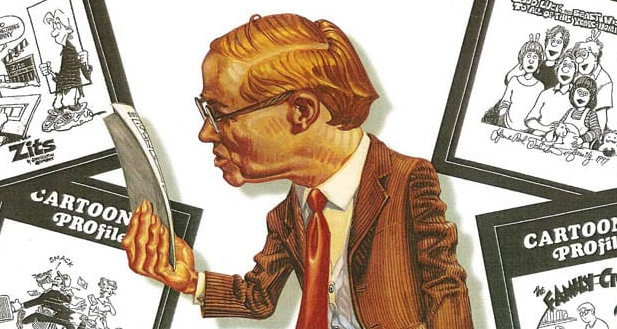
*Jud Hurd was a cartoonist and publisher of Cartoonist PROfiles.
For over thirty years, he was publisher and editor of the profession’s longest-running periodical—the industry’s leading “insider” magazine until The Comics Journal surfaced and matured—the quarterly journal Cartoonist PROfiles. In his role as editor and reporter, he telephoned others of the inky-fingered fraternity often, making several phone calls a day—interviewing cartoonists, lining up future stories, talking to syndicate officials, exploring sources of illustrative material for articles scheduled for a future issue of the magazine.
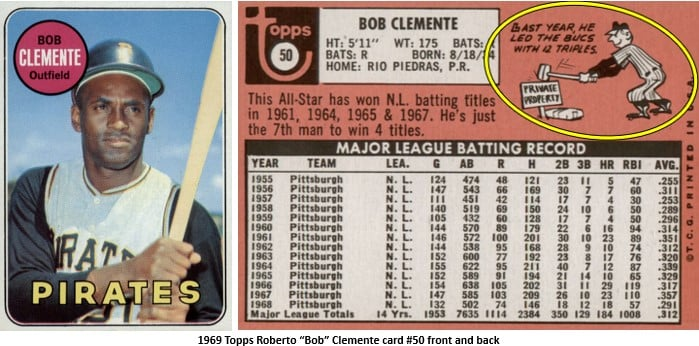

Comments 1
Comments are closed.